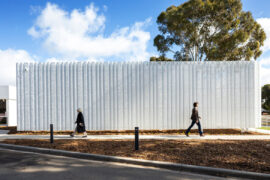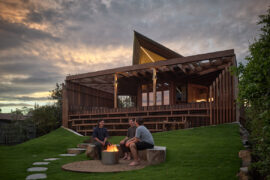Three representatives from well-known Asian hotels share their successful blueprint in designing hospitality spaces from a wellness perspective.

December 21st, 2023
Even before the COVID-19 pandemic, travellers were already seeking different experiences from their journeys abroad. Among them, wellness travel has become highly popular, defining entire hotels instead of just the spa and fitness centres.
For example, Banyan Tree Veya Phuket in Thailand offers over 40 health and wellness activities throughout the week, including singing bowl sessions, conscious grounding exercises, and pilates, aside from massages and aromatherapy sessions. The property is part of the larger Banyan Tree Phuket, which was created by Ho Kwon Cjan, Group Chief Architect of Banyan Tree Holdings.
“Wellness is a concept full of nuances. It also includes the joy of feeling at ease without any pressure, a bit like being at home. It’s a matter of details,” describes Italian architect and designer Paola Navone who, with her team at Otto Studio, created a light-hearted, breezy wellness centre for COMO Point Yamu in Phuket that offers breath-taking view of the Andaman Sea. “The fresh colours of the water and the air, and the imperfect beauty of natural materials give pleasant and light sensations that we like to experiment and to create in our practice,” she adds.
No longer simple rooms with the bare minimum equipment, wellness centres in hotels have also been given greater attention. We speak with representatives from three Asian hotels to discuss what goes into making a well-designed wellness centre.

“Wellness follows suite per the sequential experience that leads from the vibrant common grounds to a truly tranquil yet unconventional spa setting that pays tribute to a significant tree at the end of a long pond. [At the] internal circulation zone, long pond sets a dramatic reflection scene that changes as guests advance towards their dedicated treatment rooms,” says Hakan Ozkasikci on the crafted sequence toward the wellness centre at One&Only Desaru Coast, Malaysia designed by the late-Kerry Hill. He is the Executive Vice-President of Design & Technical Services at Kerzner International that developed and operates the hotel.
Treatment rooms also open to “private gardens of calm” and the reverse journey comprises walking through a tall, shadowed volume, he elaborates. “This rich and unique experience is theatrical at a subconscious level, as the treatment becomes a part of the story while the transitions between meaningful spaces are vividly remembered, unlike many other spas where the built environment has little to add to the overall memory,” he adds.

Sight, touch, smell and even sensations such as the wind help to ground one to the location. “The tactile experience is as important as the visual memory. The overall experience must comprise of local materials, warm hues of textiles, and the shadow play of the exterior jungle on the floor and the walls of these rooms. An intangible connection is thus retained through the reflection of the natural environment inside the room, and the memory of the treatment is enriched by this sensation,” observes Ozkasikci about One&Only Desaru Coast.
“In Banyan Tree Veya Phuket, we’ve opted for natural, tactile materials like locally sourced wood, stone and bamboo – materials that offer a calming touch and pleasant aroma, enhancing the sensorial experience,” says Dharmali Kusumadi, Senior Vice President of Banyan Tree Hotels & Resorts. This accompanies treatments that also use natural, locally sourced Thai herbs and oils.

Respect for local culture is important in the overall mindset of wellness, where care is not just about taking care of oneself but also the greater community and ecosystem. “Thailand is culturally rich, and we’ve honoured these traditions in our design,” says Kusumadi on the architectural elements inspired by Thai temples, traditional Thai craftsmanship and artwork. “These cultural nuances create a sense of place and authenticity that resonates with our guests.”
Likewise for Navone and her team at Otto Studio. “Ceramics is one [of Thailand’s most] developed craft. We chose to cover the walls of the spa in COMO Point Yamu with turquoise ceramics, imagining the space like a huge aquarium, far from everything. All of the wooden furniture is made by craftsmen using traditional Thai techniques,” she says.

In One&Only Desaru Coast, local materials like the durable stone and Balau timber sourced from local sustainable farms are used in the ways they have been for centuries, highlights Ozkasikci. “Colours, scents, art, folklore, movement, music, poetry, tastes, furniture, structure, details – these are all interwoven component of the story that manifest themselves in the final design.”
“City dwellers find it very easy to embrace a holistic sense of wellness here. Nature is all around you as you explore the resort. [It is important] as it has been scientifically proven that spending time in nature has an immeasurable impact on our sense of being,” says Jerome Pichon, the General Manager of One&Only Desaru Coast. Open-air corridors, timber screens that open to landscaping, massage rooms that look to gardens, are some ways for guests to constantly engage with nature.

Agrees Kusumadi, “At Banyan Tree Veya Phuket, we wanted to create a haven where guests can reconnect with themselves and their surroundings. In the spa, treatment rooms offer views of lush gardens, creating a connection to nature that enhances the overall wellness experience.”
INDESIGN is on instagram
Follow @indesignlive
A searchable and comprehensive guide for specifying leading products and their suppliers
Keep up to date with the latest and greatest from our industry BFF's!

For a closer look behind the creative process, watch this video interview with Sebastian Nash, where he explores the making of King Living’s textile range – from fibre choices to design intent.

Rising above the new Sydney Metro Gadigal Station on Pitt Street, Investa’s Parkline Place is redefining the office property aesthetic.

Merging two hotel identities in one landmark development, Hotel Indigo and Holiday Inn Little Collins capture the spirit of Melbourne through Buchan’s narrative-driven design – elevated by GROHE’s signature craftsmanship.

Making a splash on the hair spa scene, the latest project from X + O makes a little slice of Japan right at home in suburban Melbourne.

The World Architecture Festival has named The Holy Redeemer Church and Community Centre of Las Chumberas in La Laguna, Spain as World Building of the Year 2025, alongside major winners in interiors, future projects and landscape.
The internet never sleeps! Here's the stuff you might have missed

Through expert architecture, EBD Architects has provided a human face to great design and created a project that enhances the lives of people and community.

Recognised as a winner at the INDE.Awards 2025, Barton Taylor has received The Photographer – Residential accolade. His photographic work on Cake House captures the soul of a coastal icon reimagined, blending light, texture and atmosphere into a compelling visual narrative.